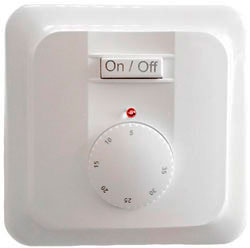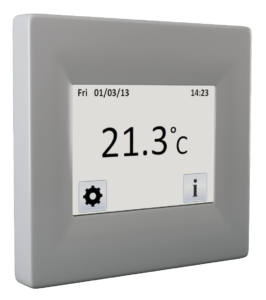Best practices – Part 4: Temperature regulation
We will end up in this last part of best practices with the temperature regulation of electric underfloor heating systems.
As for any other heating systems, the accuracy of the regulation is of prime importance not only to get the highest comfort, but also to achieve the maximum energy saving. Moreover, for electric radiant heating, temperature regulation is one of the biggest advantages of the system. Per the high reactivity and the independent control per room of the heating system, an adequate temperature regulation achieves high energy savings, keeping at all time an optimal level of comfort in the different areas of the house.
![]()
Thermostat with floor probe:
In underfloor heating system, the whole floor turns into a large low temperature heat emitter. Therefore, it is necessary to control both the ambient temperature and floor temperature for an optimal regulation control.
Floor temperature control must be carried out through an external probe connected to the electronic thermostat. This probe must be located correctly within the floor to achieve a correct regulation. The probe must be installed at least 30 cm within the heating area, between the loops of the heating cable in the centre of the loop, taking care not to touch neither to cross in any point the heating cable. The probe is placed into a conduit whose end is sealed (for instance with tape) to prevent ingress of building materials. The bend radius of the conduit between the wall and the floor must allow the probe to slide into it in both direction so that the probe could be substituted if needed. The minimum bend radius recommended is 6 cm.
The use of any other floor temperature devices, such as temperature limitation bulbs would affect significantly the correct regulation and as a consequence comfort and energy savings.
Regulation modes
Electric underfloor heating systems can be regulated in two different ways. One mode is selected during the thermostat installation but can be modified later on, within the thermostat parameters:
- Room temperature regulation with floor temperature limit for an optimal comfort. Used in most of the installations. The goal is to get the room at the desired temperature.
- Floor temperature regulation to enjoy a warm floor whenever desired. Mainly used in bathrooms to maintain a warm floor, even if the room temperature increases due to hot water steam in the room.
The maximum allowed floor temperature setting is:
- 28ºC for rooms that are used for longer periods
- 35ºC for rooms that are used for shorter period and with floor tiling.
The floor temperature limit allows the installation of underfloor heating systems below floor coverings more sensitive to heat and that requires a lower maximum temperature operation (usually 25 to 27ºC limitation according to the floor covering specifications).
Finally, floor temperature control prevents from overheating of the floor that would occur in case of thermal blockage.
Thermostat location
The thermostat that includes the ambient temperature probe and will control the room temperature should be located at aa height of 1.2 m from the floor in a place where the temperature is representative of the room temperature, avoiding atypical areas (closed to heating sources or openings, etc…).
Each room should have its own thermostat so the temperature is correctly adjusted to the setting.
Setup – First heating
For a correct setup, it is important to follow the instructions of the thermostat. The first heating should never be carried out before at least 5 days from the floor covering installation when installed in self-levelling screeds or within the tile adhesive or before 30 days when installed within concrete. Those delays are a general recommendation but, in any case, the installer should refer to the instructions given by the manufacturer of the construction material. Some thermostats include a first heating function for a progressive first heating.
Different types of thermostats and functionalities
There are different types of thermostats, from the most simple, analogical up to the most developed with distance control through WiFi.
Analogical thermostats only regulate the temperature at the setting temperature and would need manual change in the setting to adjust the temperature.

We highly recommend the use of programable thermostat that would allow to adjust in each room, sequences of period of times of comfort (20-21ºC) and period of times with reduced temperature (night, absence, etc…) according of the daily and weekly needs and the room occupation.
Moreover, our experience shows that the use of highly intuitive thermostat with touch screen or distance control, allows the end user to adjust more frequently the settings according to its needs (which are variable also), optimizing better the comfort and the energy saving for a complete end user satisfaction.

Our thermostats include other interesting functionalities to improve even more the energy savings as the open window functions, multiple temperature settings, presence detection, monitoring of the energy consumption, etc.


